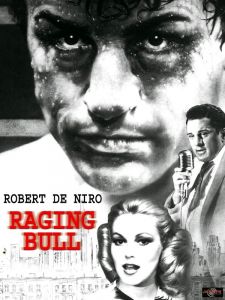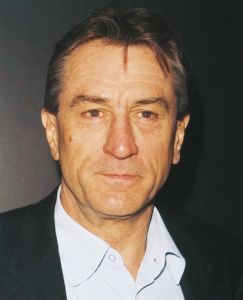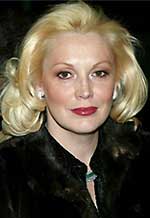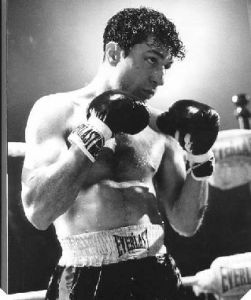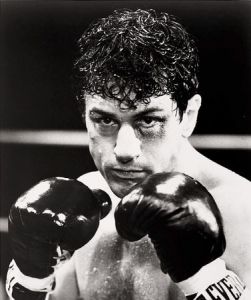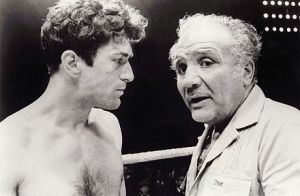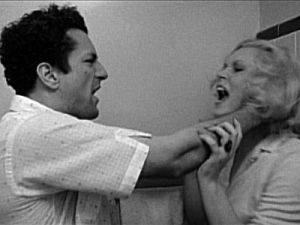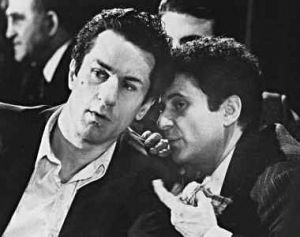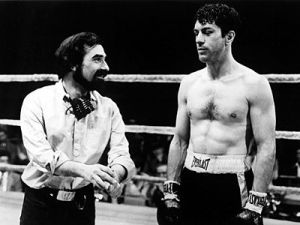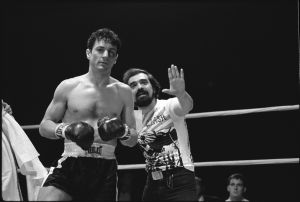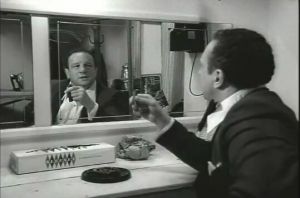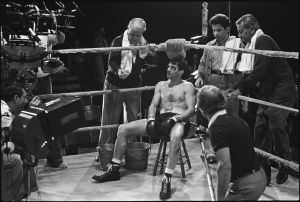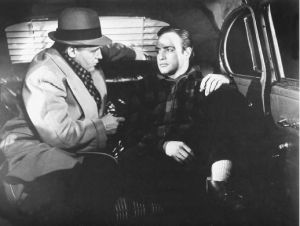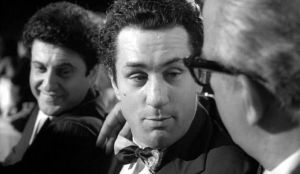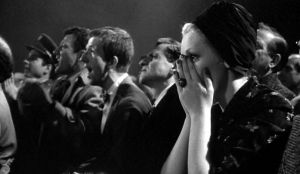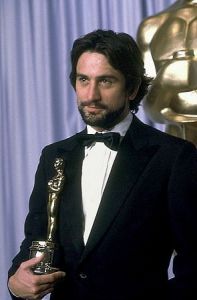Raging Bull 愤怒的公牛
Raging Bull (愤怒的公牛) is a 1980 American biographical film directed by Martin Scorsese, adapted by Paul Schrader and Mardik Martin from the Jake La Motta memoir "Raging Bull: My Story". After receiving criticism due to its disturbing level of violence, and upsetting material it went on to garner a high critical reputation and is now widely regarded among the greatest movies ever made. It is one of five films that has been named to the National Film Registry in its first year of eligibility.
Directed by: Martin Scorsese
Produced by: Robert Chartoff, Irwin Winkler
Written by: Paul Schrader, Mardik Martin, Martin Scorsese (uncredited), Robert De Niro (uncredited)
Cinematography: Michael Chapman
Editing by: Thelma Schoonmaker
Distributed by: United Artists
Release dates:
United States: December 19, 1980
United Kingdom: February 19, 1981
Running time: 129 minutes
Country: United States
Language: English
Color: Black and White, Color
Genre: Biography Drama Sport
Robert De Niro as Jake LaMotta
Joe Pesci as Joey LaMotta
Nicholas Colasanto as Tommy Como
Theresa Saldana as Lenora LaMotta (Joey's wife)
Frank Vincent as Salvy "Batts"
Mario Gallo as Mario
Cathy Moriarty as Vickie Thailer LaMotta
Frank Adonis as Patsy
Joseph Bono as Guido
Frank Topham as Toppy
Lori Anne Flax as Irma
Beginning in 1964, where an older and fatter Jake LaMotta (Robert De Niro) practices his stand-up comic routine, a flashback shifts to his boxing career in 1941 against his opponent, Jimmy Reeves, in the infamous Cleveland bout. Losing the fight by a fixed result causes a fight to break out at the end of the match. His brother Joey LaMotta (Joe Pesci) is not only a sparring partner to him but also responsible for organizing his fights. Joey discusses a potential shot for the title with one of his Mafia connections, Salvy Batts (Frank Vincent), on the way to his brother's house in their neighborhood in the Bronx. When they are finally settled in the house, Jake admits that he does not have much faith in his own abilities. Accompanied by his brother to the local open-air swimming pool, a restless Jake spots a 15-year-old girl named Vickie at the edge of the pool (Cathy Moriarty). Although he has to be reminded by his brother he is already married, the opportunity to invite her out for the day very soon comes true when Joey gives in. Jake has two fights with Sugar Ray Robinson, set two years apart, and Jake loses the second when the judges rule in favor of Sugar Ray because he was leaving the sport temporarily for conscription in the US Army.
This does not deter Jake from winning six straight fights, but as his fears grow about his wife, Vickie, having feelings for other men, particularly Tony Janiro, the opponent for his forthcoming fight, he is keen enough to show off his sexual jealousy when he beats him in front of the local Mob boss, Tommy Como (Nicholas Colasanto) and Vickie. The recent triumph over Janiro is touted as a major boost for the belt as Joey discusses this with journalists, though Joey is briefly distracted by seeing Vickie approach a table with Salvy and his crew. Joey has a word with Vickie, who says she is giving up on his brother. Blaming Salvy, Joey viciously attacks him in a fight that spills outside of the club. When Tommy Como hears that the two of them rose fists in a public place, he orders them to apologize and tells Joey that he means business. At the swimming pool, Joey tells Jake that if he really wants a shot, he will have to take a dive first. In the fight against Billy Fox, Jake does not even bother to put up a fight. Jake is suspended from the board on suspicion of throwing the fight, though he realizes the error of his judgment when it is too late. This does little to harm his career, when he finally wins the title against Marcel Cerdan at the open air Briggs Stadium.
Three years pass and Jake asks his brother if he fought with Salvy at the Copca because of Vickie. Jake then asks if Joey had an affair with his wife. Joey refuses to answer and decides to leave. Jake decides to find the truth for himself, interrogating his wife about the affair when she sarcastically states that she had sex with the entire neighborhood, including his brother, Salvy, and Tommy Como. Angrily walking straight towards Joey's house while Vicki tries to stop him. Jake enters Joey's house and brutally assaults him in front of Vicki and Joey's wife and children. Defending his championship belt against Laurent Dauthuille, he makes a call to his brother after the fight, but when Joey assumes Salvy is on the other end, Jake says nothing. This drags Jake down to when he eventually loses to Sugar Ray Robinson on their final encounter, letting Sugar Ray land several hard blows on him as punishment for what he did.
A couple of years later, in the middle of a photo shoot, Jake LaMotta surrounded by his wife and children, tells the journalists he is officially retired and that he has bought a new property. After staying out all night at his new nightclub in Miami, Vickie tells him she wants a divorce. Arrested for introducing under-age girls to men, he serves a jail sentence after failing to raise the bribe money by taking the jewels out of his championship belt instead of selling the belt itself. In his jail cell, Jake brutally pounds the walls whilst sorrowfully questioning his misfortune, as he sits alone crying in despair. Returning to New York City, he meets up with his estranged brother Joey in a parking lot where they share a nervous hug. Going back to the beginning sequence, Jake refers to the "I coulda' have been a contender" scene from On the Waterfront complaining that his brother should have been there for him but is also keen enough to give himself some slack. Darting across the room at the information of the crowded auditorium by the stage hand, the camera remains pivoted on the mirror as LaMotta chants 'I'm the boss' whilst shadow boxing. The film ends on an ambiguous note with a Biblical quote: "All I know is this: Once I was blind, and now I can see" — symbolizing that even men like LaMotta can be redeemed.
Under the guidance of Winkler, Mardik Martin was asked to start writing the screenplay. According to De Niro, under no circumstances would United Artists accept Mardik Martin's script. The story was based on the vision of journalist Peter Hamill of a 1930s and 1940s style, when boxing was known as "the great dark prince of sports". De Niro was unimpressed when he finished reading the first draft, however. Taxi Driver screenwriter Paul Schrader was swiftly brought in to re-write the script around August 1978. Some of the changes that Schrader made to the script saw a re-write of the scene with the uncooked steak and inclusion of LaMotta seen masturbating in a Florida cell. The character of LaMotta's brother, Joey, was finally added, previously absent from Martin's script. United Artists saw a massive improvement on the quality of the script.
However, its chief executives, Steven Bach and David Field, met up with Scorsese, De Niro, and producer Irwin Winkler in November 1978 to say they were worried that the content would be X-rated material and have no chance of finding an audience. According to Scorsese, the script was left to him and De Niro, and they spent two and a half weeks on the island of Saint Martin, extensively re-building the content of the film. The most significant change would be the entire scene when LaMotta fixes his television and then accuses his wife of having an affair. Other changes included the removal of Jake and Joey's father; the reduction of organized crime's role in the story and a major re-write of LaMotta's fight with Tony Janiro. According to Steven Bach, the first two screenwriters (Mardick Martin and Paul Schrader) would receive credit but since there was no payment to the writer's guild on the script, De Niro and Scorsese's work would remain uncredited
One of Scorsese's trademarks was casting many actors and actresses new to the profession, which on this occasion there would be no exception. De Niro, who was already committed to play Jake LaMotta, began to help Scorsese track down unfamiliar names to play his on-screen brother, Joey, and wife, Vickie. The role of Joey LaMotta was the first to be cast. De Niro was watching a low budget television film called The Death Collector when he saw the part of a young career criminal played by Joe Pesci as an ideal candidate. Prior to receiving a call from De Niro and Scorsese for the proposal to star in the film, Pesci had not worked in film for four years and was running an Italian restaurant in New Jersey. Pesci initially claimed that it would have to be a good role for him to consider it, and he later accepted the part. The role of Vickie LaMotta, Jake's wife, would have much interest across the board, but Pesci who suggested the actress, Cathy Moriarty, from a picture he once saw at a New Jersey disco. Both De Niro and Scorsese believed that Moriarty could portray the role after meeting with her on several occasions and noticing her husky voice and physical maturity. The duo had to prove to the Screen Actors Guild that she was right for the role when Cis Corman showed 10 comparing pictures of both Moriarty and the real Vickie LaMotta for proof she had a resemblance. Joe Pesci also persuaded his former show-biz pal and co-star in The Death Collector, Frank Vincent to try for the role of Salvy Batts. Following a successful audition and screen test, Vincent received the call to say he had received the part. Charles Scorsese, the director's father, made his film debut as Tommy Como's cousin, Charlie.
While in the midst of practicing a Bronx accent and preparing for his role, De Niro met both LaMotta and his ex-wife, Vikki on separate occasions. Vikki, who lived in Florida, would tell stories about her life with her former husband and also show old home movies. Jake LaMotta, on the other hand, would serve as his trainer accompanied by Al Silvani as coach at the Gramercy club in New York getting him into shape. The actor found that boxing came naturally to him; he entered as a middleweight boxer, winning two of his three fights in a Brooklyn ring dubbed "young LaMotta" by the commentator. According to Jake LaMotta, he felt that De Niro was one of his top 20 best middleweight boxers of all time.
Raging Bull came about when De Niro read the autobiography upon which the film is based on the set of 1900. Although disappointed by the book's writing style, he became fascinated by the character of Jake LaMotta when he showed the book to Martin Scorsese on the set of Alice Doesn't Live Here Anymore as a means to hopefully consider the project. Scorsese repeatedly turned down his offers by resisting the director's chair, claiming he had no idea what Raging Bull was about, even though he did read some chapters of the text. The book was then passed onto Mardick Martin, the film's eventual co-screenwriter. The book was even shown to producer Irwin Winkler by De Niro, who was willing to assist only if Scorsese agreed.[4] After nearly dying from a drug overdose, Scorsese agreed to make the film for De Niro's sake, not only to save his own life but also to save what remained of his career.
Preparation for the film began with Scorsese shooting some 8mm color footage featuring De Niro boxing in a ring. One night when the footage was being shown to De Niro, Michael Chapman, and his friend and mentor, the English director Michael Powell, Powell pointed out that color of the gloves at the time would have only been maroon, oxblood, or even black. Scorsese decided to use this as one of the reasons to film Raging Bull in black and white. Other reasons would be to distinguish the film from other color films around the time and to acknowledge the problem of fading color film stock - an issue Scorsese recognized. Scorsese even went to two matches at the Madison Square Garden to aid his research, picking up on minor but essential details such as the blood sponge and latterly, the blood on the ropes.
The film began shooting at a Los Angeles warehouse in April 1979. The warehouse was modified to replicate the Madison Square Garden venue in New York as the site of the boxing scenes. Scorsese made it clear during filming that he did not appreciate the traditional way in films to show fights from the spectators' view. He insisted that one camera operated by the Director of Photography, Michael Chapman would be placed inside the ring as he would play the role of an opponent keeping out of the way of other fighters so that we could see the emotions of the fighters, including those of Jake. The precise moves of the boxers would be done as dance routines from the information of a book about dance instructors in the mode of Arthur Murray. A punching bag which sat in the middle of the ring was used by De Niro between takes before aggressively coming straight on to do the next scene. The initial five-week schedule for the shooting of the boxing scenes took longer than expected, putting Scorsese under pressure.
According to Scorsese, production of the film was then closed down for around four months with the entire crew being paid, so De Niro could go on a binge eating trip around Northern Italy and France. When he did come back to the United States, his weight increased from 145 to 215 pounds (66 to 97 kg). The scenes with the heftier Jake LaMotta, which include announcing his retirement from boxing and LaMotta ending up in a Florida cell, were completed while approaching Christmas 1979 within seven to eight weeks so as not to aggravate the health issues which were already affecting De Niro's posture, breathing, and talking. The final sequence where Jake LaMotta is sitting in front of his mirror was filmed on the last day of shooting taking 19 takes, with only the thirteenth one being used for the film. Scorsese wanted to have an atmosphere that would be so cold that the words would have an impact as he tries to come to terms with his relationship with his brother.
The editing of Raging Bull began when production was temporarily put on hold and was completed in 1980. Scorsese worked with the editor, Thelma Schoonmaker to achieve a final cut of the film. Their main decision was to ditch Schrader's idea of LaMotta's nightclub act intervening with the flashback of his youth and instead just follow along the lines of a single flashback. A sound mix arranged by Frank Warner was a delicate process taking six months. According to Scorsese, the sound on Raging Bull was difficult because each punch, camera shot, and flash bulb would be different. Also, there was the issue of trying to balance the quality between scenes featuring dialogue and those involving boxing, which were done in Dolby. Raging Bull went through a test screening in front of a small audience including the chief executives of United Artists, Steven Bach and Andy Albeck. The screening was shown at the MGM screening room in New York around July 1980. Later, Albeck praised Scorsese by calling him a "true artist". According to the producer, Irwin Winkler, matters were made worse when United Artists decided not to distribute the film but no other studios were interested when they attempted to sell the rights. Scorsese made no secret that Raging Bull would be his "Hollywood swan song" and he took unusual care of its rights during post-production. This caused some friction with Irwin Winkler, who accused Scorsese of doing the editing process "inch by inch". Scorsese threatened to remove his credit from the film if he was not allowed to sort a reel which obscured the name of a whisky brand known as "Cutty Sark" which was heard in a scene. The work was completed only four days shy of the premiere.
Martin Scorsese decided to assemble a soundtrack made of music that was popular at the time using his personal collection of 78s. The songs were carefully chosen so they would be the ones that you would hear on the radio, at the pool or in bars and clubs reflecting the mood of that particular era. Some lyrics from songs would be slipped into some dialogue. The Intermezzo from Cavalleria rusticana by Italian composer Pietro Mascagni would serve as the main theme to Raging Bull after a successful try-out by Scorsese and the editor, Thelma Schoonmaker over the film's opening titles. Two other Mascagni pieces were used in the film: the Barcarolle from Silvano, and the Intermezzo from Guglielmo Ratcliff. A two-CD soundtrack was released in 2005, long after the film was released, because of earlier difficulties receiving permissions for many of the songs, which Scorsese selected from his childhood memories growing up in New York.
Jake La Motta: I'm gonna open his hole like this. Please excuse my French. I'm gonna make him suffer. I'm gonna make his mother wish she never had him - make him into dog meat... He's a nice, a nice kid. He's a pretty kid, too. I mean I don't know, I gotta problem if I should fuck him or fight him.
Tommy Como: You're crazy. Fuck him or fight him.
Salvy Batts: If you're really in love with that fucker, just watch out.
Jake La Motta: By who?
Salvy Batts: Janiro.
Jake La Motta: You mean, you want me to get him to fuck you?
Salvy Batts: Me?
Jake La Motta: Yeah.
Salvy Batts: No, I don't want him to fuck me.
Jake La Motta: I could do that easily.
Salvy Batts: How ya gonna do that?
Jake La Motta: Because I'll get youse both in a ring, I'll give youse both a fuckin' beatin', ya both can fuck each other.
Salvy Batts: I get all full of blood.
Jake La Motta: You're used to that.
more lines please check this link: http://www.liveglish.com/import-482/index.htm
Early in the film when Jake is leaning out of a back window, shouting, he is leaning right out of the window when viewed from outside, but is hardly leaning out at all when viewed from inside.
When Joey and Salvy are told to shake hands (after the fight), their hands are interlocked in one shot, but in the next, they are back in their respective laps.
A rubber tube, to carry fake blood, is visible behind Janiro's nose as Jake punches it.
When Jake and Joey are sitting at the kitchen table, Jake tells Joey to grab a towel to hit him. When Joey picks it up Jake says "Now wrap it around your hand," but the first half of the sentence seen from behind Jake focusing on Joey, Jake's mouth is not moving.
"Scorsese has made his most ambitious film as well as his finest and went on to praise Moriarty's debut performance as either she is one of the film finds of the decade or Mr. Scorsese is svengali. Perhaps both."
—Vincent Canby of The New York Times
"Raging Bull may prove to be Scorsese's finest achievement to date".
—Steven Jenkins from the British Film Institute's magazine
"the character of Jake LaMotta as one of the most repugnant characters in the history of the movies" and "Scorsese totally ignores (LaMotta's) reform school background, offering no explanation to his anti-social behavior."
—Kathleen Carroll from the The New York Times
From the story of a one time middle weight champion of the world and his apparent necessity for internal conflict and self destruction, America's greatest director in the history of cinema has carved a masterpiece of a feature, teaming up with the greatest actor of his generation in order to establish what will no doubt go down in history as one of the most powerful films of all time.
Raging bull is my favorite film. Robert de Niro's performance in this film is truly amazing and the direction from Scorsese and the script from Paul Schrader are flawless. The fight scenes are the most brutal that I have ever seen on film even though theres only like 12 minutes of them and the editing is simply brilliant. It should have earned Scorsese a best director oscar but at least they had enough sense to award de Niro the best actor oscar.
Oscar
Best Actor in a Supporting Role, Joe Pesci
Best Actress in a Supporting Role, Cathy Moriarty
Best Cinematography, Michael Chapman
Best Director, Martin Scorsese
Best Picture, Irwin Winkler, Robert Chartoff
Best Sound, Donald O. Mitchell, Bill Nicholson, David J. Kimball, Les Lazarowitz
BAFTA Awards
Most Outstanding Newcomer to Leading Film Roles, Joe Pesci
Best Actor, Robert De Niro
Most Outstanding Newcomer to Leading Film Roles, Cathy Moriarty
Golden Globes, USA
Best Director - Motion Picture, Martin Scorsese
Best Motion Picture - Drama
Best Motion Picture Actor in a Supporting Role, Joe Pesci
Best Motion Picture Actress in a Supporting Role, Cathy Moriarty
Best Screenplay - Motion Picture, Paul Schrader, Mardik Martin
New Star of the Year in a Motion Picture - Female, Cathy Moriarty
Oscar
Best Actor in a Leading Role, Robert De Niro
Best Film Editing, Thelma Schoonmaker
BAFTA Awards
Best Editing, Thelma Schoonmaker
Most Outstanding Newcomer to Leading Film Roles, Joe Pesci
Boston Society of Film Critics Awards
Best Actor, Robert De Niro
Best Cinematography, Michael Chapman
Best Film
Golden Globes, USA
Best Motion Picture Actor - Drama, Robert De Niro
Los Angeles Film Critics Association Awards
Best Actor, Robert De Niro
Best Picture
National Board of Review, USA
Best Actor, Robert De Niro
Best Supporting Actor, Joe Pesci
National Society of Film Critics Awards, USA
Best Cinematography, Michael Chapman
Best Director, Martin Scorsese
Best Supporting Actor, Joe Pesci
No.24 AFI's 100 Years... 100 Movies
No.51 AFI's 100 Years... 100 Thrills
No.1 AFI's Top 10 Sports
No.4 AFI's 100 Years... 100 Movies (10th Anniversary Edition)
附件列表
词条内容仅供参考,如果您需要解决具体问题
(尤其在法律、医学等领域),建议您咨询相关领域专业人士。
如果您认为本词条还有待完善,请 编辑
上一篇 日常美语常用动词 下一篇 考研英语阅读高频词汇

